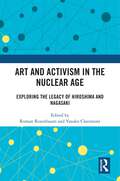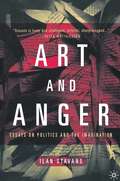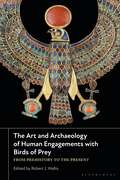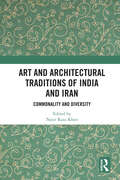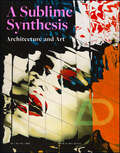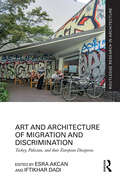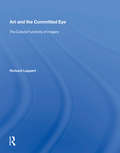- Table View
- List View
Art: Key Contemporary Thinkers
by Jonathan Vickery Diarmuid CostelloThe last few decades have witnessed an explosion in ideas and theories on art. Art itself has never been more popular, but much recent thinking remains inaccessible and difficult to use. This book assesses the work of leading thinkers (including artists) who are having a major impact on making, criticizing and interpreting art. Each entry, written by a leading international expert, presents a concise, critical appraisal of a thinker and their contribution to thought about art and its place in the wider cultural context. A guide to the key thinkers who shape today's world of art, this book is a vital reference for anyone interested in modern and contemporary art, its history, theory, philosophy and practice.Theodor ADORNO * Roland BARTHES * Georges BATAILLE * Jean BAUDRILLARD * Walter BENJAMIN * Jay BERNSTEIN * Pierre BOURDIEU * Nicholas BOURRIAUD * Benjamin BUCHLOH * Daniel BUREN * Judith BUTLER * Noël CARROLL * Stanley CAVELL * TJ CLARK * Arthur C. DANTO * Gilles DELEUZE * Jacques DERRIDA * George DICKIE * Thierry DE DUVE * James ELKINS * Hal FOSTER * Michel FOUCAULT * Michael FRIED * Dan GRAHAM * Clement GREENBERG * Fredric JAMESON * Mike KELLEY * Mary KELLY * Joseph KOSUTH * Rosalind KRAUSS * Julia KRISTEVA * Barbara KRUGER * Niklaus LUHMANN * Jean-François LYOTARD * Maurice MERLEAU-PONTY * WTJ MITCHELL * Robert MORRIS * Linda NOCHLIN * Adrian PIPER * Griselda POLLOCK * Robert SMITHSON * Jeff WALL * Melanie KLEIN * Albrecht WELLMER * Richard WOLLHEIM
Art after Empire: From Colonialism to Globalisation (Art and its Global Histories)
by Warren CarterExplores the relationship between art and visual culture in Europe and the ‘wider world’ from the early twentieth century to the contemporary era of globalisation.
Art After Instagram: Art Spaces, Audiences, Aesthetics (Routledge Advances in Art and Visual Studies)
by Lachlan MacDowall Kylie BudgeThis book explores the effects of the Instagram platform on the making and viewing of art.Authors Lachlan MacDowall and Kylie Budge critically analyse the ways Instagram has influenced artists, art spaces, art institutions and art audiences, and ultimately contemporary aesthetic experience. The book argues that more than simply being a container for digital photography, the architecture of Instagram represents a new relationship to the image and to visual experience, a way of shaping ocular habits and social relations. Following a detailed analysis of the structure of Instagram – the tactile world of affiliation (‘follows’), aesthetics (‘likes’) and attention (‘comments’) – the book examines how art spaces, audiences and aesthetics are key to understanding its rise.The book will be of interest to scholars working in art history, design, digital culture, cultural studies, sociology, education, business, media and communication studies.
Art After Instagram: Art Spaces, Audiences, Aesthetics (Routledge Advances in Art and Visual Studies)
by Lachlan MacDowall Kylie BudgeThis book explores the effects of the Instagram platform on the making and viewing of art.Authors Lachlan MacDowall and Kylie Budge critically analyse the ways Instagram has influenced artists, art spaces, art institutions and art audiences, and ultimately contemporary aesthetic experience. The book argues that more than simply being a container for digital photography, the architecture of Instagram represents a new relationship to the image and to visual experience, a way of shaping ocular habits and social relations. Following a detailed analysis of the structure of Instagram – the tactile world of affiliation (‘follows’), aesthetics (‘likes’) and attention (‘comments’) – the book examines how art spaces, audiences and aesthetics are key to understanding its rise.The book will be of interest to scholars working in art history, design, digital culture, cultural studies, sociology, education, business, media and communication studies.
Art against censorship: Honoré Daumier, comedy, and resistance in nineteenth-century France
by Erin Duncan-O'NeillHonoré Daumier (1808–79), who was imprisoned early on for a politically offensive cartoon, painted scenes from seventeenth-century theatre and literature at moments of stifling censorship later in his career. He continued to find form for dangerous political dissent in the face of intense and shifting censorship laws by drawing on La Fontaine, Molière, and Cervantes, masters of dissimulation and critique in a newly glorified literary past. This book reveals new connections between legal repression and subversive fine-arts practice, showing the force of Daumier’s role in the broader stories of image-text relationships and political expression.
Art against censorship: Honoré Daumier, comedy, and resistance in nineteenth-century France
by Erin Duncan-O'NeillHonoré Daumier (1808–79), who was imprisoned early on for a politically offensive cartoon, painted scenes from seventeenth-century theatre and literature at moments of stifling censorship later in his career. He continued to find form for dangerous political dissent in the face of intense and shifting censorship laws by drawing on La Fontaine, Molière, and Cervantes, masters of dissimulation and critique in a newly glorified literary past. This book reveals new connections between legal repression and subversive fine-arts practice, showing the force of Daumier’s role in the broader stories of image-text relationships and political expression.
Art, Agency and the Continued Assault on Authorship (Routledge Advances in Art and Visual Studies)
by Simon BlondThis book presents a counter-history to the relentless critique of the humanist subject and authorial agency that has taken place over the past fifty years. It is both an interrogation of that critique and the tracing of an alternative narrative from Romanticism to the twenty-first century which celebrates the agency of the artist as a powerful contribution to the wellbeing of the community. It does so through arguments based on philosophical aesthetics and cultural theory interspersed with case histories of particular artists. It also engages with a second issue that cannot be separated from the first. This is the question of what the role and purpose of art is in society. This has become particularly important since the 1990s because of the "social turn" in art in which it is claimed that the only valid role for art was one that had explicit social consequences. This book argues that a political role for art is valuable, but not the only one that can be envisaged nor indeed is it the most obvious or most important. Art has other social roles both as a means to engender empathy and community, and to re-enchant a world bereft of meaning and reduced to material values. The book will appeal to practising artists as well as scholars working in art history, philosophy, aesthetics, and curatorial studies.
Art, Agency and the Continued Assault on Authorship (Routledge Advances in Art and Visual Studies)
by Simon BlondThis book presents a counter-history to the relentless critique of the humanist subject and authorial agency that has taken place over the past fifty years. It is both an interrogation of that critique and the tracing of an alternative narrative from Romanticism to the twenty-first century which celebrates the agency of the artist as a powerful contribution to the wellbeing of the community. It does so through arguments based on philosophical aesthetics and cultural theory interspersed with case histories of particular artists. It also engages with a second issue that cannot be separated from the first. This is the question of what the role and purpose of art is in society. This has become particularly important since the 1990s because of the "social turn" in art in which it is claimed that the only valid role for art was one that had explicit social consequences. This book argues that a political role for art is valuable, but not the only one that can be envisaged nor indeed is it the most obvious or most important. Art has other social roles both as a means to engender empathy and community, and to re-enchant a world bereft of meaning and reduced to material values. The book will appeal to practising artists as well as scholars working in art history, philosophy, aesthetics, and curatorial studies.
Art, Allegory and the Rise of Shi’ism in Iran, 1487-1565
by Chad KiaTransforming our understanding of Persian art, this impressive interdisciplinary book decodes some of the world’s most exquisite medieval paintings. It reveals the hidden meaning behind enigmatic figures and scenes that have puzzled modern scholars, focusing on five ‘miniature’ paintings. Chad Kia shows how the cryptic elements in these works of art from Timurid Persia conveyed the mystical teachings of Sufi poets like Rumi, Attar and Jami, and heralded one of the most significant events in the history of Islam: the takeover by the Safavids in 1501 and the conversion of Iran to Shiism.
Art and Activism in the Age of Systemic Crisis: Aesthetic Resilience (Routledge Research in Art and Politics)
by Eliza Steinbock Bram Ieven Marijke De ValckThis book examines how renewed forms of artistic activism were developed in the wake of the neoliberal repression since the 1980s. The volume shows the diverse ways in which artists have sought to confront systemic crises around the globe, searching for new and enduring forms of building communities and reimagining the political horizon. The authors engage in a dialogue with these artistic efforts and their histories – in particular the earlier artistic activism that was developed during the civil rights era in the 1960s and 70s – providing valuable historical insight and new conceptual reflection on the future of aesthetic resilience. This book will be of interest to scholars in contemporary art, history of art, film and literary studies, protest movements, and social movements.
Art and Activism in the Age of Systemic Crisis: Aesthetic Resilience (Routledge Research in Art and Politics)
by Eliza Steinbock Bram Ieven Marijke De ValckThis book examines how renewed forms of artistic activism were developed in the wake of the neoliberal repression since the 1980s. The volume shows the diverse ways in which artists have sought to confront systemic crises around the globe, searching for new and enduring forms of building communities and reimagining the political horizon. The authors engage in a dialogue with these artistic efforts and their histories – in particular the earlier artistic activism that was developed during the civil rights era in the 1960s and 70s – providing valuable historical insight and new conceptual reflection on the future of aesthetic resilience. This book will be of interest to scholars in contemporary art, history of art, film and literary studies, protest movements, and social movements.
Art and Activism in the Nuclear Age: Exploring the Legacy of Hiroshima and Nagasaki
by Roman Rosenbaum Yasuko ClaremontThis book explores the contemporary legacy of Hiroshima and Nagasaki following the passage of three quarters of a century, and the role of art and activism in maintaining a critical perspective on the dangers of the nuclear age. It closely interrogates the political and cultural shifts that have accompanied the transition to a nuclearized world. Beginning with the contemporary socio-political and cultural interpretations of the impact and legacy of the destruction of Hiroshima and Nagasaki, the chapters examine the challenges posed by committed opponents in the cultural and activist fields to the ongoing development of nuclear weapons and the expanding industrial uses of nuclear power. It explores how the aphorism that ‘all art is political’ is borne out in the close relation between art and activism. This multi-disciplinary approach to the socio-political and cultural exploration of nuclear energy in relation to Hiroshima/Nagasaki via the arts will be of interest to students and scholars of peace and conflict studies, social political and cultural studies, fine arts, and art and aesthetic studies.
Art and Activism in the Nuclear Age: Exploring the Legacy of Hiroshima and Nagasaki
This book explores the contemporary legacy of Hiroshima and Nagasaki following the passage of three quarters of a century, and the role of art and activism in maintaining a critical perspective on the dangers of the nuclear age. It closely interrogates the political and cultural shifts that have accompanied the transition to a nuclearized world. Beginning with the contemporary socio-political and cultural interpretations of the impact and legacy of the destruction of Hiroshima and Nagasaki, the chapters examine the challenges posed by committed opponents in the cultural and activist fields to the ongoing development of nuclear weapons and the expanding industrial uses of nuclear power. It explores how the aphorism that ‘all art is political’ is borne out in the close relation between art and activism. This multi-disciplinary approach to the socio-political and cultural exploration of nuclear energy in relation to Hiroshima/Nagasaki via the arts will be of interest to students and scholars of peace and conflict studies, social political and cultural studies, fine arts, and art and aesthetic studies.
Art and Anger: Essays on Politics and the Imagination
by I. StavansFascinated by the idea of Western civilization as being a sequence of numerous misinterpretations and misrepresentations, these nineteen essays cover a broad range of topics with the unifying theme being the crossroads where politics and the imagination meet. An essay on linguistics and culture discusses the shaping of Latin America's collective identity; Peru's modern history is approached as a bloody battle between enlightenment and darkness; and in critiques of Octavio Paz and Gabriel García Márquez, Stavans reflects on the dichotomy between pen and sword in the Hispanic world. In 'Letter to a German Friend', Stavans returns to his fate as a Jew in the Southern Hemisphere, and in 'The First Book,' he connects his passion for literature to his initiation into Jewishness. Finally, in a meditation on Columbus's afterlife, he reflects on the many ways in which we reinvent ourselves in order to make sense of the chaotic world that surrounds us.
The Art and Archaeology of Human Engagements with Birds of Prey: From Prehistory to the Present
by Robert J. WallisOf all avian groups, birds of prey in particular have long been a prominent subject of fascination in many human societies. This book demonstrates that the art and materiality of human engagements with raptors has been significant through deep time and across the world, from earliest prehistory to Indigenous thinking in the present day. Drawing on a wide range of global case studies and a plurality of complementary perspectives, it explores the varied and fluid dynamics between humans and birds of prey as evidenced in this diverse art-historical and archaeological record. From their depictions as powerful beings in visual art and their important roles in Indigenous mythologies, to the significance of their body parts as active agents in religious rituals, the intentional deposition of their faunal remains and the display of their preserved bodies in museums, there is no doubt that birds of prey have been figures of great import for the shaping of human society and culture. However, several of the chapters in this volume are particularly concerned with looking beyond the culture–nature dichotomy and human-centred accounts to explore perspectival and other post-humanist thinking on human–raptor ontologies and epistemologies. The contributors recognize that human–raptor relationships are not driven exclusively by human intentionality, and that when these species meet they relate-to and become-with one another. This 'raptor-with-human'-focused approach allows for a productive re-framing of questions about human–raptor interstices, enables fresh thinking about established evidence and offers signposts for present and future intra-actions with birds of prey.
The Art and Archaeology of Human Engagements with Birds of Prey: From Prehistory to the Present
Of all avian groups, birds of prey in particular have long been a prominent subject of fascination in many human societies. This book demonstrates that the art and materiality of human engagements with raptors has been significant through deep time and across the world, from earliest prehistory to Indigenous thinking in the present day. Drawing on a wide range of global case studies and a plurality of complementary perspectives, it explores the varied and fluid dynamics between humans and birds of prey as evidenced in this diverse art-historical and archaeological record. From their depictions as powerful beings in visual art and their important roles in Indigenous mythologies, to the significance of their body parts as active agents in religious rituals, the intentional deposition of their faunal remains and the display of their preserved bodies in museums, there is no doubt that birds of prey have been figures of great import for the shaping of human society and culture. However, several of the chapters in this volume are particularly concerned with looking beyond the culture–nature dichotomy and human-centred accounts to explore perspectival and other post-humanist thinking on human–raptor ontologies and epistemologies. The contributors recognize that human–raptor relationships are not driven exclusively by human intentionality, and that when these species meet they relate-to and become-with one another. This 'raptor-with-human'-focused approach allows for a productive re-framing of questions about human–raptor interstices, enables fresh thinking about established evidence and offers signposts for present and future intra-actions with birds of prey.
Art and Architectural Traditions of India and Iran: Commonality and Diversity
by Nasir Raza KhanThis book presents a comprehensive overview of the historical and cultural linkages between India and Iran in terms of art and architectural traditions and their commonality and diversity. It addresses themes such as early connections between Iran, India and Central Asia; study of the Qutb Complex in Delhi; the great immigration of Turks from Asia to Anatolia; the collaboration of Indian and Persian painters; design, ornamentation techniques and regional dynamics; women and public spaces in Shahjahanabad and Isfahan; the noble-architects of emperor Shah Jahan's reign; development of Kashmir’s Islamic religious architecture in the medieval period; role of Nur Jahan and her Persian roots in the evolution of the Mughal Garden; synthesis of Indo-Iranian architecture; and confluence of Indo-Persian food culture to showcase the richness of art, architecture, and sociocultural and political exchanges between the two countries. Bringing together a wide array of perspectives, it delves into the roots of connection between India and Iran over centuries to understand its influence and impact on the artistic and cultural genealogy and the shared past of two of the oldest civilizations and regional powers of the world. With its archival sources, this book will be useful to scholars and researchers of medieval history, Indian history, international relations, Central Asian history, Islamic studies, Iranian history, art and architecture, heritage studies, cultural studies, regional studies, and South Asian studies as well as those interested in the study of sociocultural and religious exchanges.
Art and Architectural Traditions of India and Iran: Commonality and Diversity
by Nasir Raza KhanThis book presents a comprehensive overview of the historical and cultural linkages between India and Iran in terms of art and architectural traditions and their commonality and diversity. It addresses themes such as early connections between Iran, India and Central Asia; study of the Qutb Complex in Delhi; the great immigration of Turks from Asia to Anatolia; the collaboration of Indian and Persian painters; design, ornamentation techniques and regional dynamics; women and public spaces in Shahjahanabad and Isfahan; the noble-architects of emperor Shah Jahan's reign; development of Kashmir’s Islamic religious architecture in the medieval period; role of Nur Jahan and her Persian roots in the evolution of the Mughal Garden; synthesis of Indo-Iranian architecture; and confluence of Indo-Persian food culture to showcase the richness of art, architecture, and sociocultural and political exchanges between the two countries. Bringing together a wide array of perspectives, it delves into the roots of connection between India and Iran over centuries to understand its influence and impact on the artistic and cultural genealogy and the shared past of two of the oldest civilizations and regional powers of the world. With its archival sources, this book will be useful to scholars and researchers of medieval history, Indian history, international relations, Central Asian history, Islamic studies, Iranian history, art and architecture, heritage studies, cultural studies, regional studies, and South Asian studies as well as those interested in the study of sociocultural and religious exchanges.
Art and Architecture: A Sublime Synthesis (Architectural Design)
The link between architecture and art and the sublimity it can create has a history that stretches back millennia. From cave paintings to the stained glass and saintly icons in churches and cathedrals, to the geometric and calligraphic treatments of mosques and contemporary artists channelling architecture and vice versa, and so much else. This AD is about the contemporary interactions between living artists and architects, and the artistic practices, such as poetry and abstractions, that architects adopt to develop ideas for their projects. The issue features artists, architects, curators, musicians, poets and designer craftspeople, illustrating the current rich mix of architectonic constructions, interventions and set pieces that range from musical performance to exhibition designs, glass works and digital 3D scanning. It lays out the wide spectrum and beauty of these sublime correspondences, with contributions from architects about their own artistic practices, and creative works viewed through the eyes of architectural commentators. An explosion of colour, form and creative tactics for making multifaceted work that above all is architectural, it offers a cornucopia of possibilities. Contributors: Peter Baldwin, Kathy Battista, Nic Clear, Mathew Emmett, Paul Finch, Paul Greenhalgh, Hamed Khosravi, Eva Menuhin, Felix Robbins, and Simon Withers. Featured architects and artists: a-project, Captivate, Brian Clarke, Andy Goldsworthy, Barbara Hepworth, Danny Lane, Ben Johnson, Brendan Neiland, Ian Ritchie, and Zoe Zenghelis.
Art and Architecture of Migration and Discrimination: Turkey, Pakistan, and their European Diasporas (Routledge Research in Architecture)
by Esra Akcan Iftikhar DadiThis book brings together essays by established and emerging scholars that discuss Pakistan, Turkey, and their diasporas in Europe. Together, the contributions show the scope of diverse artistic media, including architecture, painting, postcards, film, music, and literature, that has responded to the partitions of the twentieth century and the Muslim diasporas in Europe. Turkey and Pakistan have been subject to two of the largest compulsory population transfers of the twentieth century. They have also been the sites for large magnitudes of emigration during the second half of the twentieth century, creating influential diasporas in European cities such as London and Berlin. Discrimination has been both the cause and result of migration: while internal problems compelled citizens to emigrate from their countries, blatant discriminatory and ideological constructs shaped their experiences in their countries of arrival. Read together, the Partition emerges from the essays in Part I not as a pathology specific to the Balkans, Middle East, or South Asia, but as a central problematic of the new political realities of decolonization and nation formation. The essays in Part II demonstrate the layered histories and multiple migration paths that have shaped the experiences of Berliners and Londoners. This analysis furthers the study of modernism and migration across the borders of, not only the nation-state, but also class, race, and gender. As a result, this book will be of interest to a broad multidisciplinary academic audience including students and faculty, artists, architects and planners, as well as non-specialist general public interested in visual arts, architecture and urban literature.
Art and Architecture of Migration and Discrimination: Turkey, Pakistan, and their European Diasporas (Routledge Research in Architecture)
This book brings together essays by established and emerging scholars that discuss Pakistan, Turkey, and their diasporas in Europe. Together, the contributions show the scope of diverse artistic media, including architecture, painting, postcards, film, music, and literature, that has responded to the partitions of the twentieth century and the Muslim diasporas in Europe. Turkey and Pakistan have been subject to two of the largest compulsory population transfers of the twentieth century. They have also been the sites for large magnitudes of emigration during the second half of the twentieth century, creating influential diasporas in European cities such as London and Berlin. Discrimination has been both the cause and result of migration: while internal problems compelled citizens to emigrate from their countries, blatant discriminatory and ideological constructs shaped their experiences in their countries of arrival. Read together, the Partition emerges from the essays in Part I not as a pathology specific to the Balkans, Middle East, or South Asia, but as a central problematic of the new political realities of decolonization and nation formation. The essays in Part II demonstrate the layered histories and multiple migration paths that have shaped the experiences of Berliners and Londoners. This analysis furthers the study of modernism and migration across the borders of, not only the nation-state, but also class, race, and gender. As a result, this book will be of interest to a broad multidisciplinary academic audience including students and faculty, artists, architects and planners, as well as non-specialist general public interested in visual arts, architecture and urban literature.
Art and Architecture of the World's Religions [2 volumes]: [2 volumes]
by Leslie D. RossTwo abundantly illustrated volumes offer a vibrant discussion of how the divine is and has been represented in art and architecture the world over.Beginning with the ancient worlds of Mesopotamia, Egypt, Greece, and Rome and moving forward through time, Art and Architecture of the World's Religions explores the major faiths from countries and continents around the globe, helping readers better understand the creations their beliefs have inspired. After tracing the history and development of a religion, the book provides a general overview of its principal beliefs and key practices. It then offers specific examples of how works of art/architecture reflect that religion's values.The focus of each chapter is on the temples, churches, and religious buildings, statues, paintings, and other works of art and architecture created by believers. Each representative work of art or architecture is examined in terms of its history, materials, symbols, colors, and patterns, as its significance is explained to the reader. With extensive illustrations, these volumes are the definitive reference work on art and architecture of the world's religions.
Art and Commerce in Late Imperial Russia: The Peredvizhniki, a Partnership of Artists
by Andrey ShabanovAndrey Shabanov's seminal reinterpretation of the Peredvizhniki is a comprehensive study that examines in-depth for the first time the organizational structure, self-representation, exhibitions, and critical reception of this 19th-century artistic partnership. Shabanov advances a more pragmatic reading of the Peredvizhniki, artists seeking professional and creative freedom in authoritarian Tsarist Russia. He likewise demonstrates and challenges how and why the group eventually came to be defined as a critically-minded Realist art movement. Unprecedentedly rich in new primary visual and textual sources, the book also connects afresh the Russian and Western art worlds of the period. A must-read for anyone interested in Russian art and culture, 19th-century European art, and also the history of art exhibitions, art movements, and the art market.
Art and Commerce in Late Imperial Russia: The Peredvizhniki, a Partnership of Artists
by Andrey ShabanovAndrey Shabanov's seminal reinterpretation of the Peredvizhniki is a comprehensive study that examines in-depth for the first time the organizational structure, self-representation, exhibitions, and critical reception of this 19th-century artistic partnership. Shabanov advances a more pragmatic reading of the Peredvizhniki, artists seeking professional and creative freedom in authoritarian Tsarist Russia. He likewise demonstrates and challenges how and why the group eventually came to be defined as a critically-minded Realist art movement. Unprecedentedly rich in new primary visual and textual sources, the book also connects afresh the Russian and Western art worlds of the period. A must-read for anyone interested in Russian art and culture, 19th-century European art, and also the history of art exhibitions, art movements, and the art market.
Art And The Committed Eye: The Cultural Functions Of Imagery
by Richard LeppertIn Art and the Committed Eye Richard Leppert examines Western European and American art from the fifteenth to the twentieth century. He studies the complex relation between the "look" of images and the variety of social and cultural uses to which they are put and demonstrates that the meaning of any image is significantly determined by its function, which changes over time. In particular, he emphasizes the ways in which visual culture is called on to mediate social differences defined by gender, class, and race. In , Leppert addresses the nature and task of representation, discussing how meaning accrues to images and what role vision and visuality play in the history of modernity. Here he explains imagery's power to attract our gaze by triggering desire and focuses on the long history of the use of representation to enact a deception, whether in painting or advertising. explores art's relation to the material world, to the ways in which images mark our various physical and psychic ties to objects. The author analyzes still life paintings whose subject matter is both extraordinarily diverse and deeply paradoxical—from flower bouquets to grotesque formal arrangements of human body parts. Leppert demonstrates that even in "innocent" still lifes, formal design and technical execution are imbued with cultural conflict and social power. is devoted to the representation of the human body—as subject to obsessive gazing and as an object of display, spectacle, and transgression. The variety of body representation is enormous: pleased or tortured, gorgeous or monstrous, modest or lascivious, powerful or weak, in the bloom of life or under the anatomist's knife, clothed or naked. But it is the sexual body, Leppert shows, that has provided the West with its richest, most complex, contradictory, conflicted, and paradoxical accounts of human identity in relation to social ideals.







